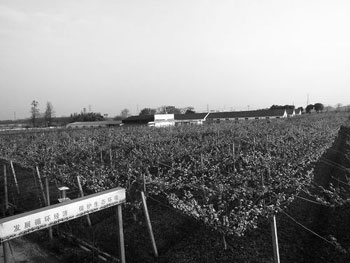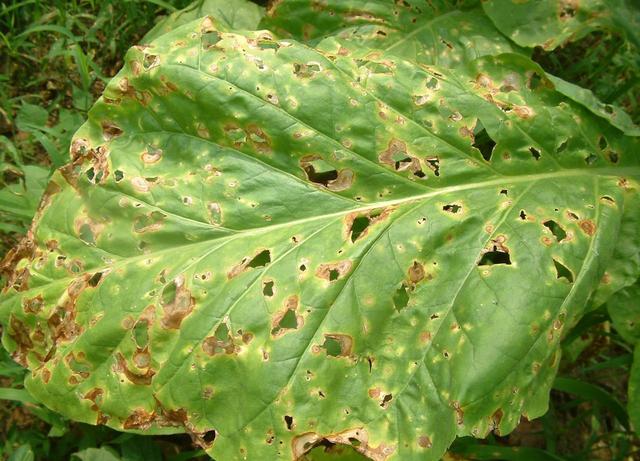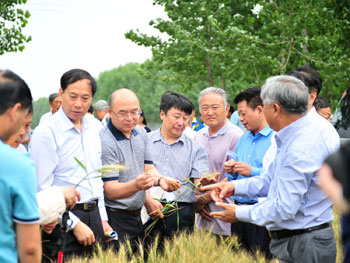Layout Circulation "Food chain" Agriculture to reduce pollution
Original title: circular agriculture opens the door of ecological protection in Taihu Lake.

Top view of ecological park
The Taihu Lake basin is one of the areas with developed economy and the most dynamic investment growth in China. The rapid economic development and the accumulation of a large number of population have caused serious water pollution in the Taihu Lake basin. In recent years, eutrophication control and cyanobacteria bloom control in Taihu Lake have been eco-environmental issues of great concern to the national and local governments.
At present, eutrophication pollutants from point sources such as industrial and mining enterprises have been greatly reduced, while non-point source pollution from surface runoff such as agriculture, rural areas and farms has not been well controlled due to technical means and economic costs. Therefore, how to effectively control non-point source pollution is still an important challenge for eutrophication control and cyanobacteria bloom control in Taihu Lake.
Based on the understanding of the above problems, Wu Jiangdong Tianmu Ecological Park (hereinafter referred to as Ecological Park) cooperated with Nanjing Agricultural University and Fudan University after more than ten years of careful design and practice. It has embarked on a path of circular agricultural development with low input, high output and low emission.
"the development model of circular agriculture should be a development direction of China's agriculture in the future, which also provides a new idea for the treatment of non-point source pollution in Taihu Lake basin." Ren Bomin, head of the ecological park, said in an interview with a reporter from China Science Daily.
Combination of cultivation and recycling
Over the years, the ecological park has made unremitting efforts to take the road of circular economy development by making use of the superior natural environment, combining agriculture, forestry, animal husbandry and fishing organically in accordance with the principle of "plant production, animal transformation and microbial reduction".
After more than 10 years of hard exploration and hard work, "at present, a relatively perfect circular agricultural economic compound ecosystem has been formed, with aquaculture and planting as the main industry, biogas digester as the waste conversion hub, and closed surrounding ecological wetlands as the means of runoff interception and purification." Ren Bomin said.
It is understood that the breeding system of the ecological park is mainly based on the breeding of Bama Xiang pigs with high added value and less resource consumption and pollution, taking into account poultry and livestock such as chickens and rabbits and special aquaculture such as rice field eel, Loach and soft-shelled turtle.
It can be seen in the ecological park that the breeding of chickens and rabbits under the forest can not only make full use of the shady environment and grass provided by the fruit forest, but also control the pests in the weeds to a certain extent. Special aquaculture such as eel, Loach and soft-shelled turtle can not only use these water spaces to obtain economic output, but also effectively control pests in ecological canals and ponds, as well as transform and utilize submerged plants that absorb eutrophication substances such as nitrogen and phosphorus.
The planting system is mainly fruit Cuiguan pear, while making full use of the open space of pear orchard and the characteristics of deciduous leaves in winter to grow high-quality forage, vegetables or traditional Chinese medicine. Forage grass can not only provide feed for the culture system, but also absorb excess biogas fertilizer that pear trees can not absorb in time during biogas slurry drip irrigation, reduce surface runoff, reduce summer surface temperature, and create a better surface environment for pear growth.
In recent years, Wang Shoubing, a professor in the Department of Environmental Science and Engineering of Fudan University, has provided important technical support for the further improvement of the circular industry chain of the ecological park. In Wang Shoubing's view, what is worth mentioning in the circular agriculture model is the closed encircling ecological wetland system set around the boundary of the whole park.
"the system carries on the orchard surface runoff on rainy days to prevent discharge pollution, and provides water when watering is needed to facilitate irrigation and save energy. In addition, planting ornamental plants and aquatic vegetables (such as hollow cabbage, water celery, etc.) with strong purification effect and high economic value in ecological wetlands can, on the one hand, play the role of purifying nitrogen, phosphorus and other nutrients; on the other hand, it can make full use of space resources and get a certain economic output. " Wang Shoubing introduced it in an interview with a reporter from China Science Daily.
According to reports, a number of circular economy industrial chains have been built and operated in the ecological park. among them, there are four representative circular economy chains: "pig-marsh-pear-human" ecological industrial chain, "pig-marsh-grass-chicken (rabbit)-human" ecological industrial chain, "pig-marsh-vegetable-human" ecological industrial chain, "pig-marsh-gully-pond-fishing (vegetable)-human" ecological industrial chain.
Ren Bomin said that in the whole circular economy system, all kinds of substances have been utilized to the greatest extent, and the goals of reduction, resource utilization, harmlessness and industrialization have been truly achieved. remarkable benefits have been achieved in energy conservation, water conservation, material conservation, comprehensive utilization of resources and cleaner production.
Scientific collocation is constantly improving.
At present, the farming scale of agricultural production bases in many places is too large because of the separation of planting and cultivation, and the one-sided pursuit of scale. And the demand for organic fertilizer in the planting industry is limited, resulting in excess feces and urine and environmental pollution from time to time.
"each unit of the park is scientifically quantified and distributed according to the ecological carrying capacity and economic efficiency of each nutrient level of the food chain." Ren Bomin said: for example, according to the amount of fertilizer needed for normal production, such as orchards and vegetable plots in the park, determine the amount of biogas dregs and liquid fertilizer, thus determine the treatment scale of anaerobic ponds and biogas digesters, and then according to the scale of biogas digesters and anaerobic ponds, combined with the production and discharge coefficient, determine the scale of Xiang pig farming and the allowable amount of sewage discharge in the farm area.
According to this process, the park uses 21.2ha of land to safely absorb livestock and poultry droppings from 5000 Bama miniature pigs per year. This method is similar to the European Union and other countries to determine the breeding scale according to the safe carrying capacity of soil to livestock and poultry manure and other pollutants. "this not only avoids the waste of resources, but also avoids environmental pollution, but also reduces the additional cost of waste transportation and disposal." Wang Shoubing said.
Although biogas digester can dispose of waste, in the opinion of experts, its economic value is still relatively low. To this end, Wang Shoubing provides a new "road" for the ecological park.
"We suggest that animal manure such as pig manure and chicken manure can be used to raise black water gadfly insects, which are saprophytic insects of the family Tabanidae, which are highly adaptable and reliably feed on livestock droppings." Wang Shoubing said.
Studies have shown that the black water gadfly larva can reduce laying hen manure or pig manure by 50% or more, reduce the available phosphorus in cow manure by 61% 70%, and nitrogen by 30% 50%, without consuming other resources (such as energy). The larvae of the black water gadfly can also inhibit the growth of bacteria and the spawning of houseflies, and effectively improve the sanitary conditions of livestock farms.
Experts point out that these worms are also high-value animal protein feed (containing 40%-44% primary protein), which can be used to feed chickens, fish, etc., further improving economic and environmental benefits.
"the intervention of science and technology has helped the ecological park to further enhance the added value and improve the circular chain." Wang Shoubing said.
Now, the black water gadfly insect has been raised in the ecological park, and the breeders are still groping for its best living conditions and living habits.
Model of agricultural non-point source pollution control
The Taihu Lake basin has abundant water, light and heat resources, and has favorable conditions for the development of agriculture, forestry, animal husbandry and fishery. There are more than 20 million mu of arable land in the basin, and the multiple cropping index is as high as 200%. The livestock and poultry breeding industry is very developed and has become one of the important sources of water pollution.
After years of treatment, although the trend of water quality deterioration in Taihu Lake has improved, it is still in a slightly eutrophic state, cyanobacteria blooms still break out from time to time, and the overall situation is still not optimistic.
Related
- A course of planting techniques and methods on how to grow carrots
- How to plant the latest tulips?
- Is it better to pick tea in the morning or in the afternoon? When is the best time for tea to be picked? what is the third or fifth tea?
- Launch Yuanxiao Happy combination Haocha + Tea Yuan healthy Taste
- Penghu Tourism "Fireworks 20 Parade with You"
- 2022 West Lake Happiness holds "Digital Revitalization Voucher" and draws iphone13 and laptop.
- Banqiao Fuzhou social houses are designed to change start-up combined with police elimination to create a safe and livable environment
- The convenient measure of "mechanical weeding" in Xinbei has been abused and the Agriculture Bureau has imposed heavy penalties on the illegal land consolidation.
- Changgeng University Joins Hands with Four Memory Factories to Rescue Memory Talent Shortage
- The list of Taiwan's top 100 MVP managers is listed by the Director-General of the Farmers' Association of Sanxia District.



